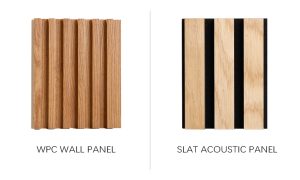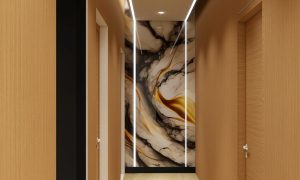
Acoustic slat wood wall panels are a type of interior wall covering designed not only for aesthetic purposes but also to improve acoustic performance in a space. These panels typically consist of wooden slats arranged in a decorative pattern, providing a visually appealing surface while also serving as acoustic treatment.
Here are some key features and benefits of acoustic slat wood wall panels:
- Material: The panels are made of wood, which adds a natural and warm aesthetic to the space. Common wood types include oak, pine, cedar, or other hardwoods.
- Slat Design: The wooden slats are arranged either horizontally or vertically, and the spacing between them can vary. The specific design can affect both the visual appeal and the acoustic performance of the panels.
- Acoustic Performance: The primary purpose of these panels is to absorb sound and reduce echoes within a room. The irregular surface created by the slats helps scatter sound waves, minimizing reverberation and improving overall sound quality.
- Versatility: Acoustic slat wood wall panels are versatile and can be used in various settings, including offices, conference rooms, auditoriums, restaurants, residential spaces, and more. They can be installed on entire walls or as accent features.
- Customization: These panels often come in a range of finishes, stains, and sizes, allowing for customization to match the design and color scheme of the surrounding environment.
- Installation: Installation methods may vary, but these panels are typically mounted directly onto the existing wall surface. Some systems may use a modular approach, allowing for easy removal and reconfiguration.
- Maintenance: Wood panels are relatively easy to maintain. Regular dusting or cleaning with a damp cloth is usually sufficient to keep them looking good.
- Environmental Considerations: Depending on the manufacturer, these panels may be sourced from sustainable forestry practices, making them an environmentally friendly choice.
When considering acoustic treatments for a space, it’s essential to assess the specific acoustic needs of the environment, as well as the desired aesthetic. Acoustic slat wood wall panels can be a stylish solution that combines functionality with design.
Production process

The production process for acoustic slat wood wall panels involves several steps, from material selection to the final finishing touches. While specific processes can vary between manufacturers, here is a general overview of the typical production stages:
- Material Selection:
- Choose high-quality wood materials for the slats. Common wood types include oak, pine, cedar, or other hardwoods, depending on the desired aesthetic and performance characteristics.
- Sizing and Cutting:
- Cut the selected wood into slats of the desired dimensions. The dimensions may vary based on the design and specifications of the wall panels.
- Surface Treatment:
- Treat the wood surfaces to enhance durability and aesthetics. This may involve processes such as sanding to achieve a smooth finish or applying a protective coating to prevent damage from moisture or other environmental factors.
- Acoustic Treatment:
- Integrate acoustic materials into the panels to enhance their sound-absorbing properties. This may involve adding acoustic batting or other materials between the slats to absorb sound waves.
- Panel Assembly:
- Arrange the wood slats according to the design specifications. The slats may be arranged horizontally, vertically, or in a custom pattern. The spacing between slats can also be adjusted to achieve the desired visual and acoustic effects.
- Backing Material (Optional):
- Some acoustic slat wood wall panels include a backing material, such as fabric or felt, to further enhance acoustic performance and provide a finished appearance on the back side.
- Frame Construction (Optional):
- Construct a frame or support structure for the panels. This frame may be made of wood or another material and is designed to facilitate easy installation on walls.
- Finishing Touches:
- Apply any final finishes, stains, or coatings to the wood surface for aesthetic purposes. This step also includes quality control checks to ensure that each panel meets the desired standards.
- Packaging:
- Package the finished panels for shipment. Proper packaging is crucial to prevent damage during transportation.
- Installation Instructions:
- Provide clear installation instructions to assist customers or installation professionals in mounting the panels on walls.
It’s important to note that variations in the production process can occur based on factors such as the specific design, customization options, and the manufacturer’s unique processes. Additionally, some manufacturers may use automated machinery for precision, while others may rely more on manual craftsmanship for a bespoke touch.
use

If you’re considering using acoustic slat wood wall panels in a space, here are some key considerations and potential applications:
- Interior Design Enhancement:
- Acoustic slat wood wall panels can be used to enhance the interior design of various spaces, including offices, conference rooms, lobbies, residential areas, and more. The natural warmth and aesthetic appeal of wood can complement a range of design styles.
- Acoustic Improvement:
- Install these panels in spaces where acoustic performance is crucial, such as in conference rooms, auditoriums, or open office environments. The slats are designed to absorb sound, reducing echoes and improving overall sound quality.
- Feature Walls:
- Create visually striking feature walls by covering entire surfaces with acoustic slat wood panels. The unique patterns and textures of the slats can serve as focal points in rooms.
- Customization:
- Take advantage of the customization options available. Choose from various wood types, finishes, and panel configurations to match the specific aesthetic and functional requirements of your space.
- Residential Spaces:
- Use acoustic slat wood panels in homes to add a touch of warmth and improve the acoustics in areas such as home theaters, living rooms, or bedrooms.
- Restaurants and Cafes:
- Enhance the ambiance of restaurants and cafes by incorporating these panels on walls. The acoustic properties can contribute to a more comfortable dining experience.
- Flexible Installation:
- The modular nature of some acoustic panel systems allows for flexible installation. Easily reconfigure or relocate the panels to adapt to changing design preferences or functional needs.
- Branding and Identity:
- Customize panels with branding elements, logos, or unique patterns to reinforce the identity of a business or organization in commercial spaces.
- Educational Facilities:
- Install acoustic slat wood panels in classrooms, lecture halls, or common areas within educational institutions to create a conducive learning environment with improved acoustics.
- Home Offices:
- Use these panels in home office spaces to create a more focused and comfortable work environment by reducing ambient noise.
Before using acoustic slat wood wall panels, it’s important to assess the specific acoustic needs of the space and ensure that the chosen panels align with the overall design vision. Additionally, proper installation following manufacturer guidelines is crucial for maximizing the acoustic benefits of the panels.

Importing acoustic slat wood wall panels into China involves navigating specific regulations and procedures. Here’s a step-by-step guide to help you with the process:
- Market Research:
- Conduct thorough market research to understand the demand for acoustic slat wood wall panels in China. Identify potential distributors, partners, or buyers.
- Product Classification and Regulations:
- Classify your acoustic slat wood wall panels according to the Chinese Harmonized System (HS) code. Check if your product requires specific certifications or compliances, such as those related to quality standards and environmental regulations.
- Establish a Legal Entity:
- If you don’t already have a presence in China, consider establishing a legal entity. This could be a representative office, a wholly foreign-owned enterprise (WFOE), or another suitable business structure.
- Import License and Permits:
- Check if your product requires an import license or special permits. Some products may have specific regulatory requirements, and obtaining the necessary licenses is crucial.
- Find a Customs Broker:
- Engage a reliable customs broker in China who is experienced in handling wood products. The customs broker can assist with documentation, customs clearance, and compliance with import regulations.
- Quality Standards and Certification:
- Ensure that your acoustic slat wood wall panels meet Chinese quality standards. Depending on the product, you may need to obtain certifications such as China Compulsory Certification (CCC) or other relevant certifications.
- Labeling and Packaging:
- Comply with Chinese labeling and packaging requirements. Ensure that the labeling is in Chinese and includes all necessary information, such as product details, origin, and safety warnings.
- Documentation:
- Prepare the required documentation, including the commercial invoice, packing list, bill of lading or airway bill, certificate of origin, and any product-specific certificates or test reports.
- Customs Declaration:
- Submit a customs declaration at the port of entry. Work closely with your customs broker to ensure accurate and timely submission of the required documents.
- Customs Clearance:
- Customs authorities will inspect the shipment and verify the documentation. Once cleared, you can proceed with the distribution of your acoustic slat wood wall panels.
- Distribution and Logistics:
- Plan the distribution of your products within China. Work with logistics partners to transport the panels to their final destination.
- Compliance with Local Regulations:
- Stay informed about changes in import regulations and compliance requirements. Regularly check for updates and ensure that your business operations align with local laws.
It’s crucial to work with professionals who have experience in importing wood products into China. This includes customs brokers, legal advisors, and quality control specialists. Additionally, building relationships with local partners and distributors can contribute to a smoother import process. Keep in mind that regulations may change, so staying informed and adaptable is essential for successful importing.






